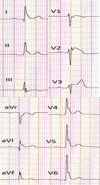J-Wave syndromes expert consensus conference report: Emerging concepts and gaps in knowledge
- PMID: 28431071
- PMCID: PMC5834028
- DOI: 10.1093/europace/euw235
J-Wave syndromes expert consensus conference report: Emerging concepts and gaps in knowledge
Keywords: Brugada syndrome; Cardiac arrhythmia; Early repolarization syndrome; Inherited cardiac arrhythmia syndrome; J wave; Sudden cardiac death; Ventricular fibrillation.
Figures







Similar articles
-
J-Wave syndromes expert consensus conference report: Emerging concepts and gaps in knowledge.Heart Rhythm. 2016 Oct;13(10):e295-324. doi: 10.1016/j.hrthm.2016.05.024. Epub 2016 Jul 13. Heart Rhythm. 2016. PMID: 27423412 Free PMC article. Review. No abstract available.
-
Enhanced transmural dispersion of repolarization in patients with J wave syndromes.J Cardiovasc Electrophysiol. 2012 Oct;23(10):1109-14. doi: 10.1111/j.1540-8167.2012.02363.x. Epub 2012 May 21. J Cardiovasc Electrophysiol. 2012. PMID: 22612896
-
The J-wave conundrum: early repolarization and Brugada syndrome.Heart Rhythm. 2013 Apr;10(4):540-1. doi: 10.1016/j.hrthm.2013.01.005. Epub 2013 Jan 8. Heart Rhythm. 2013. PMID: 23313799 No abstract available.
-
Brugada syndrome: Diagnosis, risk stratification and management.Arch Cardiovasc Dis. 2017 Mar;110(3):188-195. doi: 10.1016/j.acvd.2016.09.009. Epub 2017 Jan 27. Arch Cardiovasc Dis. 2017. PMID: 28139454 Review.
-
Is this a philosophic issue? Do patients with drug-induced Brugada type ECG have poor prognosis? (Pro).Circ J. 2010 Nov;74(11):2455-63. doi: 10.1253/circj.cj-10-0747. Epub 2010 Oct 15. Circ J. 2010. PMID: 20962432 Review.
Cited by
-
Time to consider catheter ablation as an alternative to implantable cardioverter-defibrillator therapy in high-risk patients with Brugada syndrome?Europace. 2023 Dec 6;25(12):euad338. doi: 10.1093/europace/euad338. Europace. 2023. PMID: 37949829 Free PMC article.
-
The "Five Malignant Waves" of the Eletrocardiography.Arq Bras Cardiol. 2023 Mar 10;120(3):e20220649. doi: 10.36660/abc.20220649. eCollection 2023. Arq Bras Cardiol. 2023. PMID: 36921157 Free PMC article. English, Portuguese. No abstract available.
-
Twelve-Lead ECG, Holter Monitoring Parameters, and Genetic Testing in Brugada Syndrome: Insights from Analysis of Multigenerational Family with a History of Sudden Cardiac Arrest during Physical Activity.J Clin Med. 2023 Oct 18;12(20):6581. doi: 10.3390/jcm12206581. J Clin Med. 2023. PMID: 37892719 Free PMC article.
-
Functional identification of hot-spot mutations in cardiac calcium channel genes associated with the J wave syndromes.Philos Trans R Soc Lond B Biol Sci. 2023 Jun 19;378(1879):20220286. doi: 10.1098/rstb.2022.0286. Epub 2023 May 1. Philos Trans R Soc Lond B Biol Sci. 2023. PMID: 37122210 Free PMC article.
-
Prevalence of Inherited Cardiac Conditions in Pediatric First-Degree Relatives of Patients with Idiopathic Ventricular Fibrillation.Pediatr Cardiol. 2022 Jun;43(5):1114-1121. doi: 10.1007/s00246-022-02831-1. Epub 2022 Jan 29. Pediatr Cardiol. 2022. PMID: 35092457
References
-
- Brugada P, Brugada J. Right bundle branch block, persistent ST segment elevation and sudden cardiac death: a distinct clinical and electrocardiographic syndrome: a multicenter report. J Am Coll Cardiol 1992;20:1391–1396. - PubMed
-
- Haissaguerre M, Derval N, Sacher F et al. . Sudden cardiac arrest associated with early repolarization. N Engl J Med 2008;358:2016–2023. - PubMed
-
- Rosso R, Kogan E, Belhassen B, Rozovski U, Scheinman MM, Zeltser D, Halkin A, Steinvil A, Heller K, Glikson M, Katz A, Viskin S. J-point elevation in survivors of primary ventricular fibrillation and matched control subjects: incidence and clinical significance. J Am Coll Cardiol 2008;52:1231–1238. - PubMed
-
- Wilde AA, Antzelevitch C, Borggrefe M, Brugada J, Brugada R, Brugada P, Corrado D, Hauer RN, Kass RS, Nademanee K, Priori SG, Towbin JA. Proposed diagnostic criteria for the Brugada syndrome: consensus report. Circulation 2002;106:2514–2519. - PubMed
Publication types
MeSH terms
Grants and funding
LinkOut - more resources
Full Text Sources
Other Literature Sources

